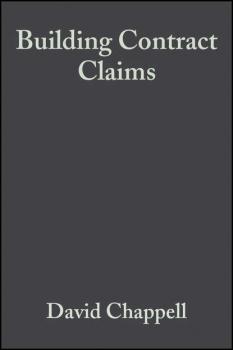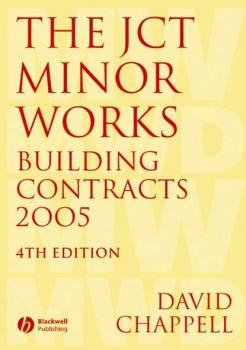ТОП просматриваемых книг сайта:















David Chappell
Список книг автора David ChappellАннотация
Many building contract claims are ill-founded, often because the basic principles are misunderstood. This highly regarded book examines the legal basis of claims for additional payment, and what can and cannot be claimed under the main forms of contract. It includes chapters dealing with direct loss and expense, liquidated damages, extension of time, concurrency, acceleration, time at large, common law and contractual claims, global claims, heads of claim and their substantiation. The new fourth edition has been substantially restructured and updated. Nearly 100 additional cases have been added as well as four new contracts: the JCT Construction Management and Major Project contracts, the JCT Standard Form of Domestic Subcontract, and the Engineering and Construction Contract (the NEC Form). The book continues to use the JCT Standard Form (JCT 98) as the basis of the text, with important differences highlighted in the other forms. Seventeen forms are dealt with and they have all been updated since the last edition of this book. This new edition is essential reading for architects, contract administrators, project managers and quantity surveyors. It will also be invaluable to contractors, contracts consultants and construction lawyers.
Аннотация
Building Contract Dictionary provides a succinct, but authoritative reference to words, phrases and terms encountered in, and in connection with, building contracts. For the new edition all entries have been reconsidered and updated in light of case law and legislation and the book has been substantially enlarged since the last edition ten years ago. There are now over 800 separate entries A wide range of contracts has been referenced, including JCT 98, IFC 98, MW 98, WCD 98, PCC 98, MC 98, ACA 3, GC/Works/1 (1998), NEC, NSC/C, DOM/1, DOM/2 as well as topics such as adjudication, arbitration and the Civil Procedure Rules. It will provide an invaluable reference for architects, quantity surveyors, project managers and contractors. It will also find a ready readership among all construction lawyers. «This is an indispensable book which provides a succinct but authoritative reference to „words, phrases and terms“ encountered in the construction industry. …many of the entries give a substantial commentary on a variety of matters you always wanted to know about but never got round to finding out.» Arbitration
Аннотация
The 2005 version of the JCT Intermediate Building Contract has introduced a very different looking contract format and a number of changes to contract conditions. A completely new Intermediate Building Contract with Contractor's Design has also been issued. This well established guide, which has been thoroughly updated, looks at the changes and key aspects of both forms, and takes account of new case law since the last edition of the book published in 1999. It also discusses the new subcontract agreements.
Аннотация
Whenever a contractor undertakes work using one of the standard building contracts, however small the job, he will be involved in writing a good many letters. Some will be formal notices he is required to give; others will be letters it is prudent to send. This book provides a set of over 270 standard letters for use with the standard forms of building contract and sub-contract and aims to cover all the common situations which contractors will encounter when involved in a contract. The letters are for use with: JCT 98 Design and Build Form WCD 98 Intermediate Form IFC 98 Minor Works Agreement MW 98 GC/Works/1 (1998) JCT Standard Form of Domestic Subcontract (2002) DOM/2 (1998) NSC/C (1998) NAM/SC (1998) GC/Works/SC (2000) The new edition takes account of substantial revisions to the standard forms of contract and introduces the new JCT Domestic Subcontract and the form of subcontract for use with GC/Works/1 (1998). New features include withholding notices and letters concerning adjudication. The book comes with a free CD, which includes all the letters, and which can be used with both Word and Word Perfect on PC and Macintosh machines. Although primarily written for contractors, the book will also be of use to subcontractors.
Аннотация
The Joint Contracts Tribunal issued a new Design and Build Form in 2005, a successor to the JCT Standard Form of Building Contract with Contractor’s Design. It looks substantially different from its predecessor and it is different in structure and often in its wording. This major new edition of David Chappell’s well regarded book has been substantially revised to take account of the new contract terms and different structure. It also considers the standard novation agreements from the CIC and City of London Law Society and more then 70 additional cases. It discusses areas where problems frequently arise: the allocation of design responsibility discrepancies the role of the employer’s agent payment provisions the approval of drawings
Аннотация
The Minor Works Building Contract is the most widely used of the JCT forms of contact, not only for simple, short contracts of moderate price, for which it is intended, but also for much larger projects for which it is often not suited at all. As a result, contractual difficulties can arise, and despite the form's simplicity an understanding of the legal background to the form is essential. This book explains the practical applications of the form from the point of view of the employer, architect and contractor. It provides a straightforward explanation of the legal aspects of the form supported by flow charts, tables and sample letters. The Fourth Edition has been revised to cover the 2005 edition of the form, which has given the contract a completely new look. The book now covers the new JCT Minor Works Building Contract with contractor's design (MWD).
Аннотация
The Joint Contracts Tribunal Standard Form of Building Contract, JCT 98, is now a well established and widely used form. That is not to say, however, that it is always well understood. It is a large, complex contract with a number of particularly difficult provisions. It is not surprising, therefore, that not much guidance has been published on the form. This book, first written by John Parris in 1982, and revised in 1985, was widely regarded as a valuable commentary on the Standard Form. Unavailable for some years, it has now been substantially updated and completely rewritten by David Chappell. Major changes have occurred since the last edition, including a raft of amendments to the contract itself, much new legislation including the Housing Grants, Construction and Regeneration Act 1996, and substantial new case law. The book covers all these as well as the complex performance specified work provisions and the difficult problems of nomination. The nominated sub-contract conditions are referred to where appropriate, and the book contains guidance on related matters, such as warranties, letters of intent and quantum meruit. The book is not simply a re-writing of the contract in simply terms. It contains very valuable insights and much needed guidance on some of the lesser known implications of the current form The book will provide a valuable reference for clients' professional advisers and contractors, as well as for lawyers needing an introduction to the contract.
Аннотация
Throughout its many editions, The Architect in Practice has remained a leading textbook used in the education of architects. While the content of the book has developed, the message and philosophy has remained constant: to provide students of architecture and young practitioners with a readable guide to the profession, outlining an architect's duties to their client and contractor, the key aspects of running a building contract, and the essentials of management, finance and drawing office procedure. The eleventh edition follows in that tradition. The text has been brought up to date to ensure it follows the new RIBA Plan of Work 2013 as the guide to the architect’s workflow. In addition, a number of changes to standard forms of contract were made with the publication of the JCT 2011 suite of contracts, and the RIBA Standard Form for the Appointment of an Architect 2010 (2012 Revision). These new forms are fully covered. In addition, the opportunity has been taken to reorganise the layout so that the content flows in a way that is more consistent with current architectural practice, and to deal with the increasing use of BIM. The eleventh edition of The Architect in Practice continues to provide the guidance and advice all students and practising architects need in the course of their studies and in their profession.
Аннотация
The revised and updated edition of this classic book on the JCT Minor Works Building Contracts The JCT Minor Works Building Contracts 2016 offers a concise overview of this agreement, which continues to be the most popular JCT contract, as it used on the sorts of small works that most architects and builders encounter routinely. Written in straightforward terms, the book is formatted in short chapters with accessible sub-headings, and the author avoids legal and pseudo-legal wording where possible. Some explanations from first principles are included where it is thought they would be helpful and occasionally, where the precise legal position is unclear, the author uses his significant experience to offer a view. Overall, the information is presented in a manner that it is easy to understand, use and reference. The 2016 edition of the contract contains a great many changes from previous editions and these are all covered. For example, the book includes information about the substantially revised payment provisions, changes to those parts dealing with insurance, variation instructions, the CDM Regulations, Supplemental Provisions, definitions, and the Contractor's Designed Portion. In summary, this fifth edition has been comprehensively revised and updated to: Ensure the discussion is easy to comprehend and use by busy architects and contractors Include a Include a number of tables and flowcharts to assist in understanding the way the contract operates Include several letter templates that can be used in common situations Provide answers to the sorts of problems that commonly arise in the course of a building project The new edition of this classic book on The JCT Minor Works Building Contracts will be an ideal tool for busy architects and contractors who need to find what to do when problems arise on projects using this contract.
Аннотация
Many building projects are the subject of claims – the assertion of a right, usually by the contractor, to an extension of the contract period or an additional payment under the terms of the building contract. Many of these claims are unsound or ill-founded, often because the basic principles are misunderstood. This highly regarded book examines the legal basis of claims for extensions of time and additional payment, and what can and cannot be claimed under the main forms of contract. It includes chapters dealing with direct loss and expense, liquidated damages, extension of time, concurrency problems, acceleration, time at large, common law and contractual claims, global claims, and heads of claim and their substantiation. With the publication of the fifth edition, Building Contract Claims has been thoroughly revised to ensure it is fully up to date with the latest contracts, court judgments and building practice. Changes include: Coverage of over 60 additional relevant court cases Coverage of the 2005 JCT contracts suite Coverage of changes to the NEC contract Coverage of additional contracts such as Constructing Excellence; Measured Term Contract and the ACA PPC2000 contract together with the 2005 relevant JCT sub-contracts Important changes to liquidated damages and to extensions of time, and the giving of notices Appendix 1 has been substantially revised Like its predecessors, the fifth edition of Building Contract Claims will be essential reading for architects, contract administrators, project managers and quantity surveyors, as well as contractors, contracts consultants and construction lawyers.










